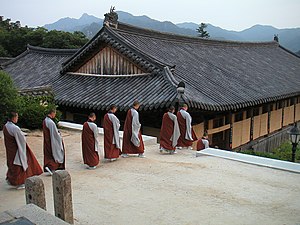Korea
The traditional dress known as hanbok (한복, 韓服) (known as joseonot [조선옷] in the DPRK) has been worn since ancient times. The hanbok consists of a shirt (jeogori) and a skirt (chima).
According to social status, Koreans used to dress differently, making clothing an important mark of social rank. Impressive, but sometimes cumbersome, costumes were worn by the ruling class and the royal family. These upper classes also used jewellery to distance themselves from the ordinary people. A traditional item of jewellery for women was a pendant in the shape of certain elements[which?] of nature which was made of precious gemstones, to which a tassel of silk was connected.
Common people were often restricted to undyed plain clothes. This everyday dress underwent relatively few changes during the Joseon period. The basic everyday dress was shared by everyone, but distinctions were drawn in official and ceremonial clothes.
During the winter people wore cotton-wadded dresses. Fur was also common. Because ordinary people normally wore pure white undyed materials, the people were sometimes referred to as the white-clad people.
Hanbok are classified according to their purposes: everyday dress, ceremonial dress and special dress. Ceremonial dresses are worn on formal occasions, including a child's first birthday (doljanchi), a wedding or a funeral. Special dresses are made for purposes such as shamans, officials.
Today the hanbok is still worn during formal occasions. The everyday use of the dress, however, has been lost. However, elderly still dress in hanbok as well as active estates of the remnant of aristocratic families from the Joseon Dynasty. Though this may be changing with something of a modern interest in the traditional dress among some of the young.[16]
Cuisine
Rice is the staple food of Korea. Having been an almost exclusively agricultural country until recently, the essential recipes in Korea are shaped by this experience. The main crops in Korea are rice, barley, beans and Gochujang (hot pepper paste), but many supplementary crops are used. Fish and other seafood are also important because Korea is a peninsula.
Fermented recipes were also developed in early times, and often characterize traditional Korean food. These include pickled fish and pickled vegetables. This kind of food provides essential proteins and vitamins during the winter.
A number of dishes have been developed. These can be divided into ceremonial foods and ritual foods. Ceremonial foods are used when a child reaches 100 days, at the first birthday, at a wedding ceremony, and the sixtieth birthday. Ritual foods are used at funerals, at ancestral rites, shaman's offerings and as temple food.
A distinguishing characteristic of Temple Food is that it does not use the common five strong-flavoured ingredients of Korean cuisine--(garlic, spring onion, wild rocambole, leek, and ginger), and meat.
Kimchi is one of the famous foods of Korea. Kimchi is pickled vegetables which contain vitamins A and C, thiamine, riboflavin, iron, calcium, carotene, etc. There are many types of kimchi including cabbage kimchi, spring onion kimchi, cucumber kimchi, radish kimchi, and sesame kimchi.
For ceremonies and rituals rice cakes are vital. The colouring of the food and the ingredients of the recipes are matched with a balance of yin and yang.
Today, surasang (traditional court cuisine) is available to the whole population. In the past vegetable dishes were essential, but meat consumption has increased. Traditional dishes include ssambap, bulgogi, sinseollo, kimchi, bibimbap, and gujeolpan.
Tea
Originally tea was used for ceremonial purposes or as part of traditional herbal medicine. Some of teas made of fruits, leaves, seeds or roots are enjoyed. Five tastes of tea are distinguished in Korea: sweet, sour, salty, bitter, and pungent.
Festivals of the lunar calendar
Daeboreum
The traditional Korean calendar was based on the lunisolar calendar.[17] Dates are calculated from Korea's meridian. Observances and festivals are rooted in Korean culture. The Korean lunar calendar is divided into 24 turning points (절기, jeolgi), each lasting about 15 days. The lunar calendar was the timetable for the agrarian society in the past, but is vanishing in the modern Korean lifestyle.
The Gregorian calendar was officially adopted in 1895, but traditional holidays and age reckoning are still based on the old calendar.[17][18] Older generations still celebrate their birthdays according to the lunar calendar.
The biggest festival in Korea today is Seollal (the traditional Korean New Year). Other important festivals include Daeboreum (the first full moon), Dano (spring festival), and Chuseok (harvest festival).
There are also a number of regional festivals, celebrated according to the lunar calendar. See also Public holidays in North Korea and Public holidays in South Korea.
Beliefs
The original religion of the Korean people was Shamanism, which though not as widespread as in ancient times, still survives to this day. Female shamans or mudang are often called upon to enlist the help of various spirits to achieve various means.
Buddhism and Confucianism were later introduced to Korea through cultural exchanges with Chinese dynasties. Buddhism was the official religion of the Goryeo dynasty, and many privileges were given to Buddhist monks during this period. However, the Joseon period saw the suppression of Buddhism, where Buddhist monks and temples were banned from the cities and confined to the countryside. In its place a strict form of Confucianism, which some see as even more strict than what had ever been adopted by the Chinese, became the official philosophy.[19] Korean Confucianism was epitomized by the seonbi class, scholars who passed up positions of wealth and power to lead lives of study and integrity.





Comments